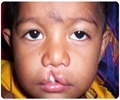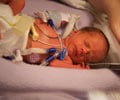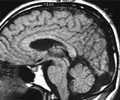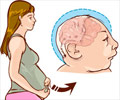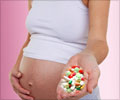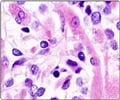Researchers, with the use of imaging studies, have tried to shed new light on the link between alcohol and birth defects.

The findings of the new study also illustrate how the precise timing of that exposure could determine the specific kinds of defects.
"We now know that maternal alcohol use is the leading known and preventable cause of birth defects and mental disability in the United States," Sulik said.
"Alcohol's effects can cause a range of cognitive, developmental and behavioral problems that typically become evident during childhood, and last a lifetime," she said.
Fetal alcohol syndrome (FAS) is at the severe end of fetal alcohol spectrum disorders (FASD).
First described in 1972, FAS is recognized by a specific pattern of facial features: small eyelid openings, a smooth ridge on the upper lip (absence of a central groove, or philtrum), and a thin upper lip border.
Advertisement
Johnson has developed new imaging tools with spatial resolution up to a million times higher than clinical magnetic resonance imaging (MRI). These include small bore tools suitable for imaging fetal mice that are only 15 mm long.
Advertisement
In the study, Lipinski and Sulik treated one group of mice with alcohol on their seventh day of pregnancy, a time corresponding to the third week of pregnancy in humans.
A second group of mice was treated just 36 hours later, approximating the fourth week of human pregnancy. The amount of alcohol given was large, "high doses that most women wouldn't achieve unless they were alcoholic and had a tolerance for alcohol," Sulik said.
Near the end of pregnancy, the fetuses were then imaged at Duke University. These 3D data sets showed individual brain regions, as well as accurate and detailed facial surfaces, from which Hammond and research assistant and co-author Michael Suttie performed shape analyses.
The team found that the earlier alcohol exposure time elicited the classic FAS facial features, including characteristic abnormalities of the upper lip and eyes. What they observed in fetuses exposed just 36 hours later, however, was a surprise.
These mice exhibited unique and in some cases opposing facial patterns, such as shortened upper lip, a present philtrum, and the brain, instead of appearing too narrow in the front, appeared wide.
"Overall, the results of our studies show that alcohol can cause more than one pattern of birth defects, and that the type and extent of brain abnormalities-which are the most devastating manifestation of prenatal alcohol exposure-in some cases may be predicted by specific facial features," Sulik said.
"And, importantly, alcohol can cause tremendously devastating and permanent damage at a time in development when most women don't recognize that they're pregnant," she added.
The study has been published online in the journal PLOS ONE.
Source-ANI

